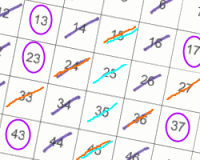Or search by topic
Number and algebra
Geometry and measure
Probability and statistics
Working mathematically
Advanced mathematics
For younger learners
Being Playful with Numbers - Secondary

This collection of resources encourages you to be playful with numbers.
There are games that require you to think strategically, problems that challenge you to make conjectures and work systematically, and articles that offer insights into the structure of number.
Got It



A game for two people, or play online. Given a target number, say 23, and a range of numbers to choose from, say 1-4, players take it in turns to add to the running total to hit their target.
Summing Consecutive Numbers



15 = 7 + 8 and 10 = 1 + 2 + 3 + 4. Can you say which numbers can be expressed as the sum of two or more consecutive integers?
Missing Multipliers



What is the smallest number of answers you need to reveal in order to work out the missing headers?
Factors and Multiples Game



A game in which players take it in turns to choose a number. Can you block your opponent?
Product Sudoku



The clues for this Sudoku are the product of the numbers in adjacent squares.
American Billions



Play the divisibility game to create numbers in which the first two digits make a number divisible by 2, the first three digits make a number divisible by 3...
Generating Triples



Sets of integers like 3, 4, 5 are called Pythagorean Triples, because they could be the lengths of the sides of a right-angled triangle. Can you find any more?
Divisibility Tests
This article explains various divisibility rules and why they work. An article to read with pencil and paper handy.

